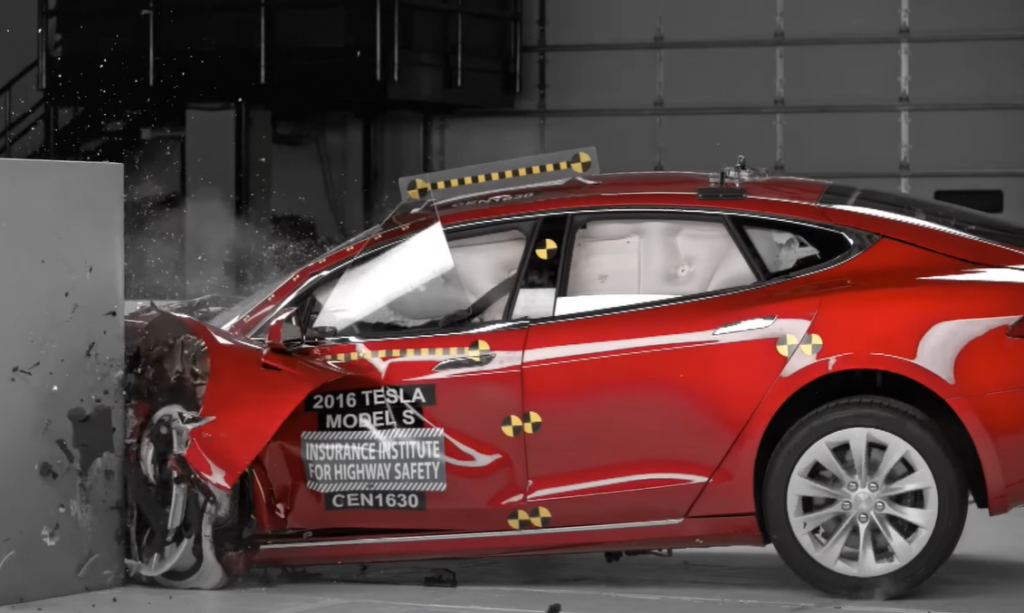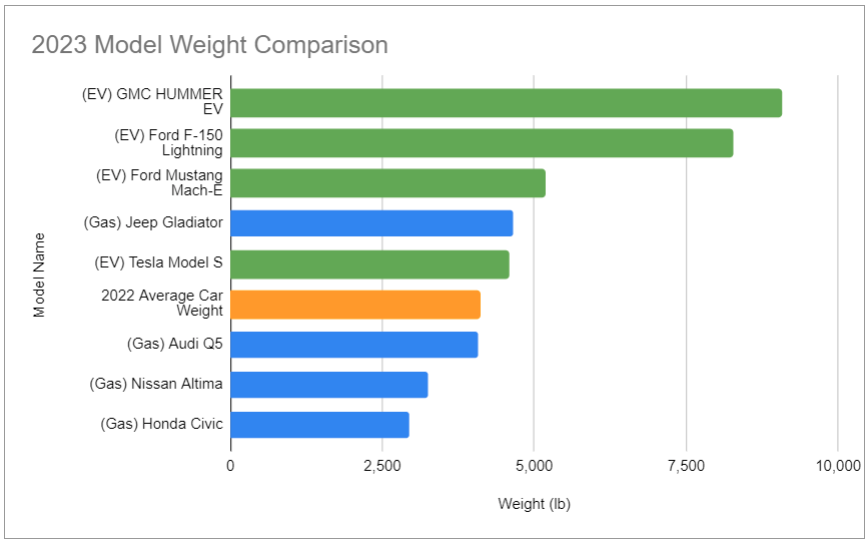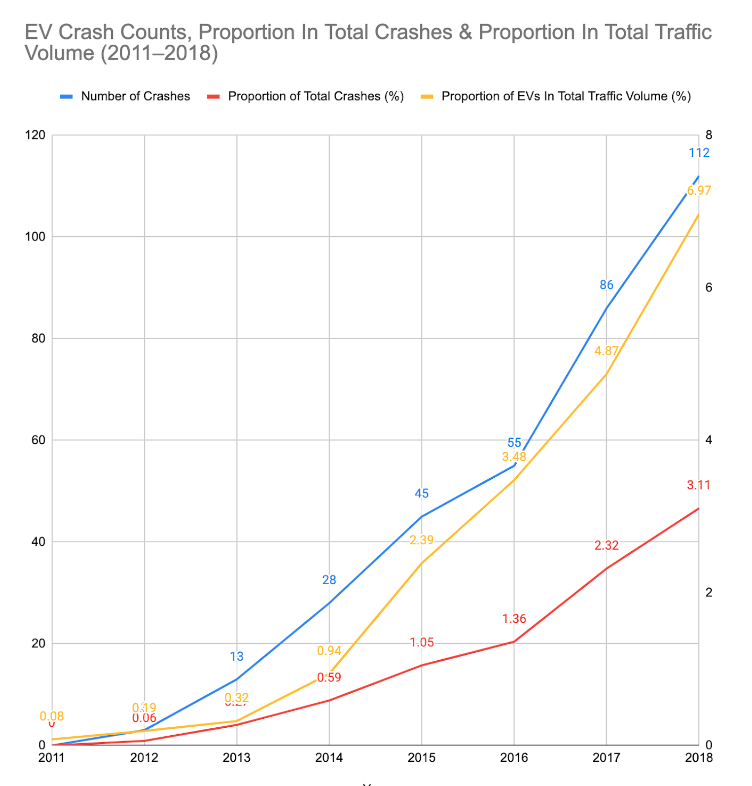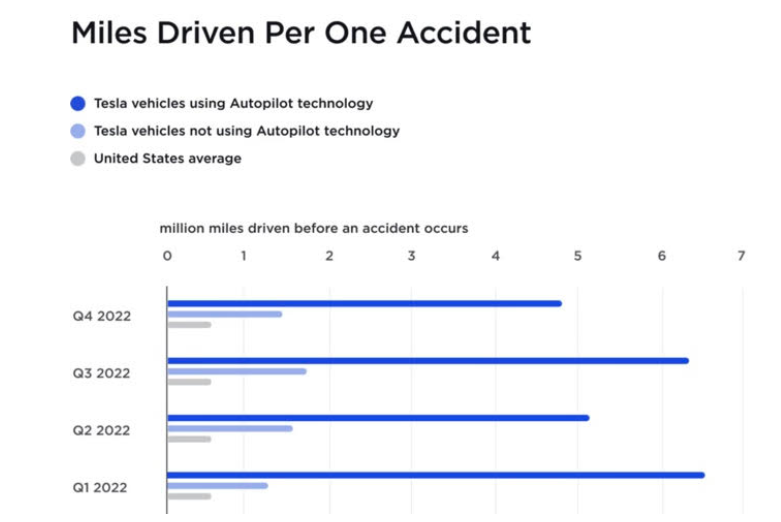With annual sales of electric cars predicted to reach over 1 million for the first time in the U.S. this year, there have never been more electric vehicles (EVs) on the road. While the environmental benefits of EVs are well known, do electric cars make American roads safer or more dangerous than conventional vehicles?
In this article, we will delve into the latest data to uncover the frequency and severity of electric car accidents, as well as the unique safety challenges posed by the electrification of cars.

KEY INSIGHTS
- The U.S. has one of the highest rates of motor-vehicle deaths in the developed world, with an estimated 46,270 fatalities in 2022.
- As of January 2024, there were more than 3.14 million electric cars on the road in the U.S., representing roughly 1.2% of all cars in circulation.
- Q1 2022 saw a 20% decline in sales of ICE vehicles and a 37% uptick in EV sales compared to Q1 2021.
- Road traffic deaths in 2022 were down 2% from 46,980 in 2021 but up 9% from 42,339 in 2020.
- EVs have a 40 percent lower probability of injury than gas-powered/ICE vehicles.
- For every 210 million miles traveled by a Tesla, there is about one fire incident, whereas ICE vehicles report one fire incident for every 19 million miles traveled.
- On average, in a crash, EVs suffer 50% more damage than typical gas-powered cars.
- EVs have a 0.03% chance of catching fire, whereas a gas-powered vehicle has 1.5% or about 50 times more likely to catch fire. At 3.14%, hybrid vehicles have the highest chance of vehicle fire.
- New EV owners are three times more likely to be in a crash partly because drivers aren’t used to instant torque associated with EVs.
- One-third of EV accidents involve cyclists and pedestrians, about 1.5 times more than ICE crashes. Predominantly this is because EVs are relatively silent than ICE.
- 47% of EVs involved in high-speed accidents end up being totalled.
- Between 2013 and 2017, there were 41 documented fatal EV accidents, of which 1 caught fire (2.44%). In comparison, in the same period, there were 20,315 fatal accidents involving ICE vehicles, out of which 644 caught fire (3.17%) and 543 fatal crashes involving hybrid vehicles, in which 12 caught on fire (2.21%).
- EVs, on average, are 35% heavier than their ICE counterparts. The added weight puts other road users at risk during an accident.
- Between 2013-2017, there were 41 documented fatal EV accidents out of which 1 caught fire (2.44%). In comparison, in the same period there were 20,315 fatal accidents involving ICE vehicles out of which 644 caught fire (3.17%) and 543 fatal crashes involving hybrid vehicles in which 12 caught on fire (2.21%).
- Experts believe the sample data for EV fires is still too thin to come out with any solid conclusion.
- Since 2010, there have been 200 recorded EV fire incidents.
- Between 2018 and 2021, 10 of 13 documented EV crashes occurred in a Tesla vehicle.
- On average, the cost of EV insurance is 27% higher than that of an ICE vehicle.
ARE ELECTRIC CARS SAFER IN ACCIDENTS THAN GASOLINE-POWERED CARS?
Electric cars are heavy – far heavier than their internal combustion engine counterparts. This extra weight comes from the battery, which increases in size and weight the more powerful and long-range the vehicle. The below chart highlights the weight difference between the latest EV models and an equivalent gas-fuelled version:

2023 MODEL WEIGHT COMPARISON
| Vehicle type | Vehicle model | Maximum Curb Weight (lb) |
| SUV | (EV) GMC HUMMER EV | 9,063 |
| Truck | (EV) Ford F-150 Lightning | 8,250 |
| Hatchback | (EV) Ford Mustang Mach-E | 5,176 |
| Truck | (Gas) Jeep Gladiator | 4,650 |
| Sedan | (EV) Tesla Model S | 4,561 |
| 2022 Average Car Weight | 4,094 | |
| SUV | (Gas) Audi Q5 | 4,079 |
| Sedan | (Gas) Nissan Altima | 3,244 |
| Hatchback | (Gas) Honda Civic | 2,935 |
This weight difference carries significant safety implications, both positive and negative. For the occupants of an electric car – it’s good news: they are less likely to be injured or killed in a crash because heavier cars have more momentum and resist rollovers due to a lower center of gravity. According to the Insurance Institute for Highway Safety (IIHS), the rates of injury claims between 2011-2019 from drivers and passengers of EV crashes were more than 40% less than from occupants of conventional cars.
On the other hand, when a heavy car collides with a lighter car, the lighter car changes direction abruptly, often spinning out of control. Consequently, more force is exerted on the people in the lighter vehicle than the heavier vehicle. Studies show that if you’re involved in a crash with a heavier vehicle, your chance of fatality increases by 47% with every 1,000 pounds of added weight.
The other factor affecting safety is that today’s electric cars have record levels of horsepower and acceleration. The GMC Hummer EV has 1000 horsepower and can accelerate from 0 to 60mph in three seconds. Most drivers are not accustomed to such high-performance vehicles, so it is feared this could lead to dangerous driving practices such as speeding.
To minimize the risk of heavier, more powerful electric cars, the most significant safety feature is Advanced Driver Assistance Systems. As EVs tend to be the latest models on the market, they have effective crash-prevention technology built in. Driver assistance aims to identify and react to potential hazards faster than a human driver. Given that 94% of crashes involve driver error, there is enormous scope for EV technology to reduce the number of car accidents.
PEDESTRIAN AND CYCLIST VULNERABILITY
Pedestrian deaths have risen 80% since a record low in 2009, accounting for 17% of crash fatalities. Cyclists represent 2% of all road traffic deaths. In a contest between car versus pedestrian or cyclist, the car always has the upper hand, electric or not. However, the higher mass of EVs, in combination with American drivers’ preference for larger SUVs and trucks, presents an acute threat to pedestrians and cyclists. Heavier cars require longer stopping distances but it is unclear whether the braking power of electric cars matches their additional weight.
In addition, pedestrians and cyclists rely on sound to alert them to the presence of an oncoming car. EVs, including hybrid vehicles operating solely on electricity, emit less sound than conventional cars. Studies showed that the odds of colliding with a pedestrian were:
- 39% higher for hybrids than for nonhybrids in areas where speed limits were 35mph or slower
- 66% higher for hybrids when performing certain maneuvers such as turning, stopping, and reversing
To lower the risk of these low-speed collisions, in February 2021, legislation was introduced that required all new electric and hybrid vehicles to produce a motor-like sound when moving forward or in reverse at speeds up to 19mph. Even at higher speeds, EVs are quieter than those with internal combustion engines, so an increased probability of collision still exists. As a result, forward crash avoidance systems and rear cameras are essential to mitigate this risk.
HOW COMMON ARE ELECTRIC CAR ROAD TRAFFIC ACCIDENTS?
Currently, national traffic accident statistics are not categorized by fuel type. However, we can gain insight into the frequency and trends of electric car crashes from a 2022 Norwegian study.
Key findings include:
- EV crashes increased from zero in 2011 to 112 in 2018, accounting for just 3.1% of all road traffic accidents while making up almost 7% of total traffic volume.

| Year | Number of Crashes | Proportion of Total Crashes (%) | Proportion of EVs In Total Traffic Volume (%) |
| 2011 | 0 | 0 | 0.08 |
| 2012 | 3 | 0.06 | 0.19 |
| 2013 | 13 | 0.27 | 0.32 |
| 2014 | 28 | 0.59 | 0.94 |
| 2015 | 45 | 1.05 | 2.39 |
| 2016 | 55 | 1.36 | 3.48 |
| 2017 | 86 | 2.32 | 4.87 |
| 2018 | 112 | 3.11 | 6.97 |
- 50% of electric car crashes happen in urban areas versus 33% of gasoline-powered car crashes, suggesting that city dwellers are early adopters of EVs
- There are fewer EV crashes at the weekend compared to internal combustion engine vehicles (17.6% vs 24.1%). This observation indicates that EVs are typically used for commuting to work
- A higher proportion of EV accidents happen during the morning and afternoon rush hour periods compared with ICEVs (5.5% in the morning peak and 32.5% in the afternoon peak for EV crashes versus 10.4% in the morning peak and 26.2% in the afternoon peak for ICEV crashes). This data strengthens the hypothesis that EVs are used for commuting as opposed to long-distance journeys
Additionally, Tesla safety reports highlight the impact of autonomous driving technology on reducing the frequency of car accidents:

ARE ELECTRIC CAR BATTERIES DANGEROUS?
Almost all electric cars are powered by highly flammable lithium-ion batteries. Under certain conditions, these batteries are incredibly volatile. There have been many reported high-profile incidents of fire and defects, including:
- A spontaneous lithium-ion battery fire on a ship carrying 4,000 new cars destined for the U.S. sunk the vessel in March 2022
- In 2021, GM recalled every Chevrolet Bolt EV and Bolt EUV they had made because their batteries could have been defective and caused a fire. The estimated cost of the recall was $1 billion
- In February 2022, State Farm filed a lawsuit against Tesla after one of its Tesla vehicles caught fire when charging and caused $1.2 million in damages to a home in Indiana
- Eight electric cars caught fire in Florida after Hurricane Ian in November 2022, after being submerged in water
Fires in lithium-ion batteries are triggered by a process called thermal runaway. This chain reaction causes a battery cell to heat up uncontrollably. It is caused by:
- Short-circuiting
- Damage to the battery from impact during an accident, even in minor collisions
- Overheating
- Condensation and moisture in the battery pack
- A manufacturing defect or design flaw
Electric car fires burn hotter and longer than ICEV fires, often releasing toxic fumes. They can also reignite days after being put out. Firefighters in the U.S. are used to dealing with petroleum fires but they often do not have the necessary experience and equipment to extinguish EV fires easily.
Fortunately, the sensationalist news stories surrounding battery fires do not reflect the actual risk. Analysis of fatal car crashes that involved fire between 2009-2014 showed that the rate of catching fire between EVs and ICEVs was about the same.
More recently, Tesla’s latest safety data reveals that between 2012-2021, there was approximately one Tesla vehicle fire for every 210 million miles traveled. By comparison, data from the National Fire Protection Association and the U.S. Department of Transportation shows that in the U.S., there is one vehicle fire for every 19 million miles traveled.
CONCLUSION
As the number of electric vehicles on American roads continues to rise, understanding the safety implications is becoming increasingly important. Automakers must continue to develop safety features that benefit not only the driver and passengers but all road users. Despite the current concerns around weight, horsepower, acceleration, and batteries, electric cars are not inherently more dangerous than gasoline-powered cars. In fact, with advances in crash-prevention technology, electric cars could be the key to reducing road traffic accidents in the U.S.
Sources:
- https://www.coxautoinc.com/market-insights/q1-2023-ev-sales/
- https://www.whitehouse.gov/briefing-room/statements-releases/2023/02/15/fact-sheet-biden-harris-administration-announces-new-standards-and-major-progress-for-a-made-in-america-nation
- al-network-of-electric-vehicle-chargers/
- https://injuryfacts.nsc.org/motor-vehicle/overview/preliminary-estimates/
- https://iea.blob.core.windows.net/assets/dacf14d2-eabc-498a-8263-9f97fd5dc327/GEVO2023.pdf
- https://www.edmunds.com/car-reviews/
- https://www.youtube.com/watch?v=8xkBoc9bKc4
- https://www.nber.org/papers/w17170
- https://injuryfacts.nsc.org/motor-vehicle/occupant-protection/advanced-driver-assistance-systems/ https://www.iihs.org/topics/pedestrians-and-bicyclists#electric-and-hybrid-vehicles
- https://etrr.springeropen.com/articles/10.1186/s12544-022-00529-2
- https://www.forbes.com/sites/neilwinton/2022/03/02/electric-car-fire-risks-look-exaggerated-but-more-data-required-for-definitive-verdict/?sh=408d28312327
- https://www.youtube.com/watch?v=XWq-Mq1Uqpw
- https://www.forbes.com/sites/neilwinton/2022/03/02/electric-car-fire-risks-look-exaggerated-but-more-data-required-for-definitive-verdict/?sh=408d28312327 https://en.wikipedia.org/wiki/Plug-in_electric_vehicle_fire_incidents
- https://www.insurancebusinessmag.com/us/news/auto-motor/floridas-electric-vehicles-are-catching-fire-after-hurricane-ian-426452.aspx
- https://www.tesla.com/en_gb/VehicleSafetyReport
- https://etrr.springeropen.com/articles/10.1186/s12544-022-00529-2
